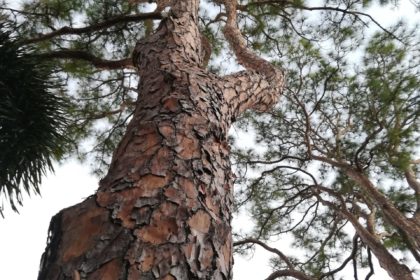
The first time I set foot on this property, gazing skyward up the length of the sand pines, I felt both right at home and in a place so unique that I had almost never seen one quite like it. The xeric sandhill habitat is delicate, yet difficult to overcome. Attempts to change it will result in frustration and cursing the white powder sand that gives it its name, as well as the names of the common species inhabiting it: sand pine, sand live oak, crooked stem. These plants favor the porous, well-draining white soils of higher elevation Florida. They establish and spread well with fire, scant nutrients, and ephemeral water. This is a habitat so rare that only a small percent remains. But it is an atmosphere you’ll never forget. This archetype is unforgettable. Visit it once and you’ll understand what fits here and looks fitting and characteristic. Let me tell you about some of the characters that really make an impression.
Lyonia ferruginea, Rusty Lyonia, Crookedbranch, Staggerbush. Crookedbranch is the cane of an old crone or wizard. It zig-zags back and forth, as if with the seasons, to capture light. Something of its shape confers wisdom and patience. Its rusty tips and arrow-shaped leaves help you to identify it. Slow growing and compact, rusty lyonia is a plant you can get to know over time.
Quercus geminata, Sand Live Oak. Similarly crooked-natured, sand live oak, is nothing less than a grand presence in this landscape. Like something out of a fairytale, sand live oak’s branches bend this way and that, unbelievably twisted. It’s small cupped leaves savor moisture and make it resilient in drought.
Serenoa repens, Saw Palmetto. This Alligator back saw palmetto could be over 500 years old. Another slow-growing specimen biding its time in this nutrient poor habitat is the fire-resistant, iconic Florida saw palmetto.
Walking into the habitat feels like a forest home, complete with a pine straw carpet, strange but familiar. For days after entering the place, I felt like an elevated human being. Something about its wildness was enlivening for me. Perhaps it reminded me of the eastern Florida sandhills in which I grew up. The short leaves of the sand pines reminded me of those I recall flexibly swaying in dark afternoon thunderstorm winds. These places are so uniquely fierce and all their own. Stefan and I have so much gratitude for not only the chance to work wtih Louise and spend time with her property, but also for her reverence for the land she and other creatures call home. Like the five or so gopher tortoises, like “Beanie,” who she sneaks blackberries as a treat, or, the screech owl resting on the cabbage palm frond we spotted on our first visit. Not only are these habitats unique, special, and worth preserving in their own right, but they are also the home to equally unique fauna.
Identification
If you believe your yard might be a sandhill, here are some characteristic signs:
- Typically higher in elevation (+30 ft. in Florida)
- White sandy soil
- Presence of nearby sand pines or sand live oaks
Management
- This habitat is fire dominated. Replicate fire by thinning oaks, removing brush, removing invasives. When properly maintained, the sandhill habitat is relatively open. You can see through the forest into the distance, either above or around the saw palmettos and under the pines.
- Look into the legalities and safety concerns of prescribed burns in your area
- The habitat will eventually evolve to oak hammock without maintenance/fire
Biodiversity
If you believe you’re on sandhill habitat but it has been deforested or uncharacteristic species have been added, begin by removing known invasive species. Next determine which exotic species are approachable for management or removal. Uncharacteristic (nonnative) species of the sandhill habitat might look out of place or seem not to match the rest of the aesthetic. Furthermore, in this rough terrain, they probably will be struggling to get enough water and nutrients and likely won’t be thriving. Maintain the habitat to encourage wildlife and natural biodiversity or selectively add appropriate sandhill plants from your local native plant nursery. Refer to UF IFAS and FNPS publications for information about native sandhill species, such as this informative article: “Sandhill Forests.”
If your landscape goals include other objectives besides landscaping for wildlife such as food production, a distinctive biodiverse edge between native sandhill habitat and food production can assist in readability of your landscape. This distinction helps guide the eye from familiar tamed lands to the more wild nature of the sandhill habitat while keeping your regular maintenance to a minimum and your wild habitat relatively undisturbed.
Providing ample habitat for wildlife in neighborhoods is essential for birds and mammals to find enough food, shelter, water, and places to raise young. Reclaiming a suburban yard as sandhill (if it is) can not only provide this habitat, it can improve your connection to place immensely. If you ever have a chance to visit a native sandhill habitat, you will never curse Florida’s sandy soil, but instead be enchanted by a place so wild, quirky and unlike anything you have seen before, you’ll want to reclaim it in places it has been domesticated and masked with plants that don’t belong there. Our eyes evolved with these landscapes, and in one as completely distinctive as the sandhill habitat, it is easy to see the non-natives. The aesthetic is easy to appreciate in its complete form and desirous in a partial form. Reclaim wild sandhill Florida forever!

